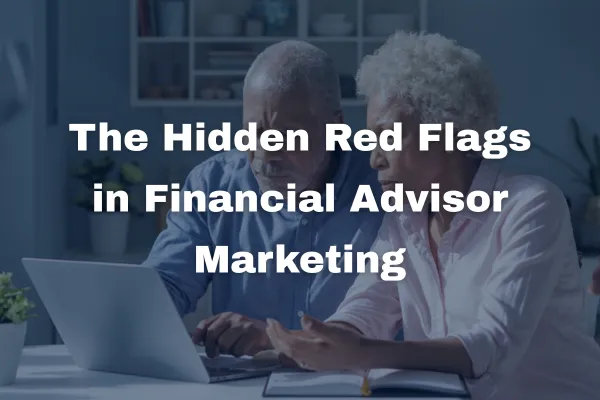
The Hidden Red Flags in Financial Advisor Marketing
The Hidden Red Flags in Financial Advisor Marketing
(How Institutions Separate Appearance from Accountability)
“Investors don't spot red flags becuase they don't know what to look for” - Paul Powell
If you’ve ever spoken with more than a few financial advisors, you’ve probably noticed something: they all look and sound the same.
Everyone talks about “personalized guidance,” “holistic planning,” and “putting clients first.” They use the same language, the same tone, and often, the same promises.
It’s not that they’re being dishonest — it’s that the language of financial advice has become standardized. What once differentiated competence has blurred into sameness.
And when everyone sounds credible, it becomes hard to tell who actually is.
For investors who follow the Educated Investors approach — or simply want to evaluate advisors with the discipline institutions use — the solution isn’t to listen harder. It’s to look deeper.
Institutions don’t judge advisors by what they say; they judge them by what they can prove. They look for process, documentation, and transparency — the quiet indicators of genuine professionalism.
Once you start looking that way, the sameness disappears — and the real differences become clear.

When Experience Isn’t Expertise
Key Idea: Years in the business don’t always mean mastery.
Many advisors highlight tenure as proof of skill. But institutional reviewers know that experience only matters when it’s relevant to the investor’s actual needs.
Professionals ask a different set of questions:
Is the advisor’s background aligned with the challenge at hand — retirement planning, business exits, tax strategy, or fiduciary oversight?
Can they show measurable results from comparable situations?
Do they hold advanced, relevant credentials such as CFP®, CFA, or CPA?
Is their performance documented or simply described?
Why It Matters: Longevity builds comfort. Relevance builds results. Institutions reward evidence of mastery — not just years of service.
The Language of “Comprehensive” and “Holistic”
Key Idea: If everything is a priority, nothing is.
Words like comprehensive and holistic sound reassuring, but they often signal a lack of focus.
Institutional committees expect precision — documented deliverables, defined responsibilities, and measurable outcomes.
When a firm claims to “do it all,” professionals look for proof:
What, specifically, is included in their “comprehensive” service?
Can they provide a written service calendar or scope of work?
How do they define and measure success for each area?
What do they not do — and who handles those areas instead?
Why It Matters: Breadth looks impressive in marketing. Depth creates confidence in execution. Institutions prize clarity over comfort.
The Credential Gap
Key Idea: Confidence without credentials is just marketing.
True professionals display credentials that are verifiable and subject to external standards.
Designations like CFP®, CFA, and CPA represent education, ethics, and ongoing accountability.
Firms that list vague “certifications” or omit credentials altogether often rely on confidence instead of competence.
Are their credentials recognizable and verifiable?
Are they current and in good standing?
Do they maintain continuing education or professional oversight?
Why It Matters: A credential isn’t a title — it’s evidence of professional discipline.
Over 80% of institutional mandates require verifiable credentials in good standing. Individual investors should expect the same.
Emotional Language in Place of Process
Key Idea: Empathy builds comfort. Process builds confidence.
Advisors often lead with good intentions: “We care deeply about our clients,” or “You’re not just a number here.”
Those statements are heartfelt — but they reveal little about how the firm actually operates.
There’s nothing wrong with warmth, but warmth isn’t a substitute for structure.
Institutions look for process language: how advice is formed, tested, reviewed, and reported.
Does the firm explain how decisions are made and evaluated?
Is there a written process for reviews and reports?
Are results compared to benchmarks or simply discussed informally?
Can you see a sample of their reporting or meeting summaries?
Why It Matters: Good relationships feel safe. Great ones show proof.
Institutions don’t assume trust — they verify it through structure.
Hidden Fees and Ambiguous Compensation
Key Idea: Opacity is the easiest red flag to measure — and the hardest to excuse.
If a firm’s materials don’t clearly describe how they’re compensated — whether through flat fees, assets under management, or commissions — investors can’t accurately assess incentives.
Institutions demand full disclosure before engagement. So should individuals.
Is the fee structure visible or only revealed after a meeting?
Are all compensation sources disclosed, including referral or platform fees?
How would their pay change if they recommended a different strategy?
Why It Matters: Transparency isn’t a courtesy — it’s a cornerstone of trust.
Clear costs protect both the investor and the integrity of the relationship.
The Visual Story
Key Idea: Design reveals intent.
A firm that relies heavily on luxury imagery — yachts, sunsets, private jets — is appealing to aspiration, not accountability.
Institutional-grade firms often communicate something very different: process, clarity, and results.
What story do their visuals tell — lifestyle or discipline?
Does the imagery reflect professionalism or aspiration?
Are charts, service calendars, or process visuals visible anywhere?
Why It Matters: Design isn’t decoration. It’s communication.
Firms that lead with lifestyle sell comfort. Firms that lead with clarity sell confidence.
Seeing What Institutions See
Most investors don’t miss red flags because they’re careless — they miss them because no one ever showed them what to look for.
Institutions have long understood that accountability and transparency must come before confidence.
Individual investors can adopt the same mindset — by asking for evidence instead of accepting appearances.
Good marketing creates comfort.
Great advisors create confidence through evidence.
Next Step: Access the Full Framework
Download “Financial Self-Defense”
The complete 27-question checklist that helps you apply the Evidence-Based Hiring™ process with institutional rigor.